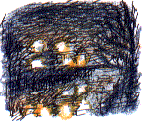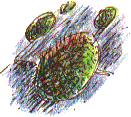 |
Cygnus OverheadThursday, 16th November 2000, West Yorkshire |
![]()
![]()
![]()
![]()
![]() Nature
Diary Rocks
History
Workshop
Links
Home Page
Nature
Diary Rocks
History
Workshop
Links
Home Page
![]()
 THE MORNING SUN catches filaments of moss in brilliant sidelight. This cushion moss - Tortula muralis, a common moss on walls - has found a niche on the rough surface of a north-facing brick wall alongside our shady front garden. Each of the slender filaments is topped by an elongated capsule, like a thin flame at the end of a very slender candle. The capsule acts as a pepperpot to distribute the spores. A new moss plant grows from the spore.
THE MORNING SUN catches filaments of moss in brilliant sidelight. This cushion moss - Tortula muralis, a common moss on walls - has found a niche on the rough surface of a north-facing brick wall alongside our shady front garden. Each of the slender filaments is topped by an elongated capsule, like a thin flame at the end of a very slender candle. The capsule acts as a pepperpot to distribute the spores. A new moss plant grows from the spore. Each of the tiny tongue-shaped leaves of this species has a long fine hair-point. In dry weather these show up as a silvery fur over the green cushion of the moss.
Each of the tiny tongue-shaped leaves of this species has a long fine hair-point. In dry weather these show up as a silvery fur over the green cushion of the moss.Genetically there's quite a difference between the leafy moss plant and the Sporophyte, (the stem and capsule) which grows from an egg in the moss's female 'flower'.
The cells of the moss plant and its spores are haploid; they contain a single set of chromosomes.
The cells of sporophyte are diploid; they contain two sets of chromosomes, one from each parent.
Cygnus overhead
 When the clocks went back for the winter recently my habitual walk to the post office to catch the last collection became a sunset stroll. It is now rapidly becoming more of a dash in the dusk. Instead of sunset over the Calder I'm now seeing the first stars emerging as I walk back over the bridge.
When the clocks went back for the winter recently my habitual walk to the post office to catch the last collection became a sunset stroll. It is now rapidly becoming more of a dash in the dusk. Instead of sunset over the Calder I'm now seeing the first stars emerging as I walk back over the bridge.This evening, through a gap in the clouds the cross-shaped constellation of Cygnus the Swan, is visible, directly overhead. It lies on the galactic plain, which in a dark sky would be marked by the band of the Milky Way across the sky. It's rare to see the Milky Way locally, even on a moonless night, because of light pollution from street lighting, but scanning with low-powered binoculars reveals the starfields in this part of the sky.
![]()
Richard Bell,
wildlife illustrator
E-mail; 'richard@willowisland.co.uk'
![]() Next page
Previous page
This day last year
Nature Diary
Home Page
Next page
Previous page
This day last year
Nature Diary
Home Page
![]()